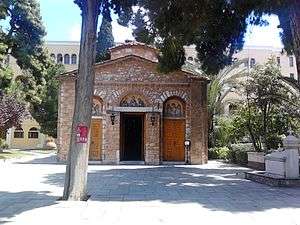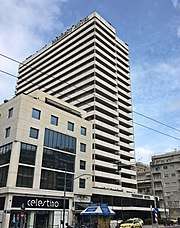Ampelokipoi, Athens
Ampelokipoi or Ampelokipi (Greek: Αμπελόκηποι, pronounced [am.beˈlo.ci.pi]), meaning 'vineyards', is a large, central district of the city of Athens. Ampelokipoi is in the centre of Athens, near Zografou, Goudi, Psychiko and Pagkrati. The area is famous for hosting Panathinaikos's home ground since it was inaugurated in 1922.
Ampelokipoi Αμπελόκηποι | |
|---|---|
Neighborhood | |
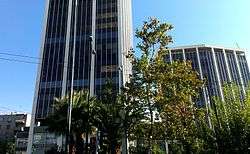 Athens Towers in Ampelokipoi | |
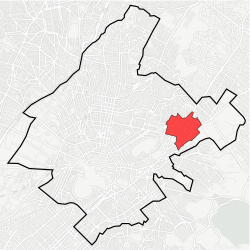 Location within Athens municipality | |
| Coordinates: 37°59′23″N 23°45′53″E | |
| Country | Greece |
| Region | Attica |
| City | Athens |
| Postal code | 115 22, 115 23, 115 24, 115 26 |
| Website | www.cityofathens.gr |
Two metro stations are located in the district.
- Ambelokipi station
- Panormou station
History
_Greece_-_Geographicus_-_Attica-t-1814.jpg)
Before the Greek independence, at the beginning of the 19th century, Ampelokipoi was a village a few kilometers north-east of Athens. The village Ampelokipoi is noted in the maps of this period. In the late 19th century, the village still remained outside the boundaries of Athens agglomeration.[1] Then some cottages of rich Athenians were built in this area. Due to its healthy climate, many hospitals were built in Ampelokipoi in the late 19th century and the beginning of the 20th.[2] Today in this area there are the hospitals Erythros Stavros Hospital (Red Cross), Errikos Dynan Hospital, Ippokrateio Hospital, Elpis Hospital and Agios Sabbas Hospital. The population explosion in Ampelokipoi happened after the Asia Minor Disaster, in 1922, when many refugees settled in this area. For the residence of the refugees, the government had originally chosen the area of the stadium of Panathinaikos that had been built in the same period.[3] So a conflict broke out between refugees and Panathinaikos fans and finally the government changed the place for the settling of refugees. The new district was named Kountouriotika and was located around of Panathinaikos stadium.[4] Few years later the government built a new neighbourhood for the refugees opposite of Panathinaikos stadium, known as prosfygika of Alexandras Avenue. These houses were built between 1933 and 1935 and today some of them have proclaimed monuments of historical heritage.[5]
Sports
Ampelokipoi is where Panathinaikos' ground lies today. It as also the home to Ampelokipoi B.C., a basketball club founded in 1929.
| Sport clubs based in Ampelokipoi | ||||
|---|---|---|---|---|
| Club | Founded | Sports | Achievements | |
| Panathinaikos A.O. | 1908 (originally as Football Club of Athens) | Football, basketball, volleyball, water polo, track and field and others | One of the most successful clubs in Greece. Most successful Greek club in European competitions (football and basketball) | |
| Ampelokipoi B.C. | 1929 (originally as Hephaestus Athens) | Basketball | Earlier presence in A1 Ethniki basketball | |
Buildings
Important buildings located in the area:
Government buildings
- Hellenic Police Headquarters (Αστυνομικό Μέγαρο)
- Court of Cassation (Greece) (Άρειος Πάγος)
- Athens Prefecture Building (Νομαρχία Αθηνών)
Hospitals
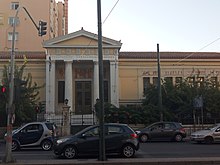
- Erythros Stavros Hospital (Red Cross)
- Errikos Dunant Hospital (Henry Dunant)
- Hippokrateio Hospital
- Elpis Hospital
- Agios Savvas Hospital
Schools
- Formerly the Philippine School in Greece (Katipunan Philippines Cultural Academy)[6]
Other
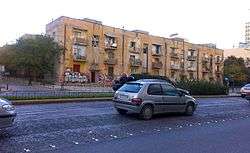
- Panathinaikos A.O. Stadium
- Athens Tower (Πύργος των Αθηνών)
- Apollo Tower (Πύργος Απόλλων) - the tallest residential tower in Greece.[7] It is 80m tall and consists of 25 floors.
- Prosfygika of Alexandras Avenue
- Petraki Monastery
Hotels
Cinemas
- Aavora
- Alfavil
- Astron
- Athinaion
- Danaos
- Galaxias
- Nirvana
- ODEON Zina
- Plaza
Residential streets
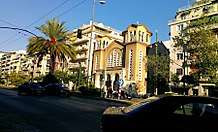
This is a list of residential streets in the Ampelokipoi area. Most of these are named after geographic locations:
- Acarnanias Street
- Achaias Street
- Alexandras Avenue
- Amaliados Street
- Ampelakion Street
- Aretaiou Street
- Aoou Street
- Aphaeas Street
- Argolidos Street
- Artis Street
- Boeotias Street
- Colchidos Street
- Corinthias Street
- Daskalaki Street
- Dimitsanas Street
- Doukissis Plakentias Street
- Elsin Street
- Estias Street
- Etolias Street
- Evrytanias Street
- Gytheiou Street
- Kalamon Street
- Kalavrias Street
- Karystou Street
- Kedrinou Street
- Komotinis Street
- Lamias Street
- Larissis Street
- Lasithiou Street
- Loudias Street
- Louizis Riankour Street
- Maiandroupoleos Street
- Megalou Spilaiou Street
- Messinias Street
- Nileon Street
- Panormou Street
- Papada Street
- Pavli Street
- Peramou Street
- Phocidos Street
- Phthiotidos Street
- Portarias Street
- Pouliou Street
- Sevastoupoleos Street
- Sithonias Street
- Stageiron Street
- Theophanous Street
- Trifyllias Street
- Trikalon Street
- Tyanon Street
- Vardousion Street
- Vatopediou Street
- Velestinou Street
- Vrastovou Street
- Vytinas Street
References
- "Η Αθήνα τον 19ο αιώνα: Από επαρχιακή πόλη της Οθωμανικής Αυτοκρατορίας, πρωτεύουσα του Ελληνικού Βασιλείου". eie.gr. Archived from the original on 22 December 2017. Retrieved 16 April 2015.
- "Ιστορία". 12dim-athin.att.sch.gr. Retrieved 16 April 2015.
- "Οι μικρασιάτες πρόσφυγες του 1922 εγκαθίστανται στους Αμπελοκήπους". mikrasiatis.gr. Retrieved 16 April 2015.
- "H σύγκρουση των φιλάθλων του Παναθηναϊκού με τους Μικρασιάτες πρόσφυγες". mixanitouxronou.gr. Retrieved 16 April 2015.
- "Προσφυγικές Πολυκατοικίες". eie.gr. Retrieved 16 April 2015.
- "KAPHILCA or Katipunan Philippines Cultural Academy Archived 2015-09-24 at the Wayback Machine." Embassy of the Philippines in Athens. Copyrighted 2007. Retrieved on September 24, 2015. "KAPHILCA is located at No. 64 Pontou Street, Ambelokipi, Athens."
- http://www.emporis.com/application/?nav=building&id=110578
